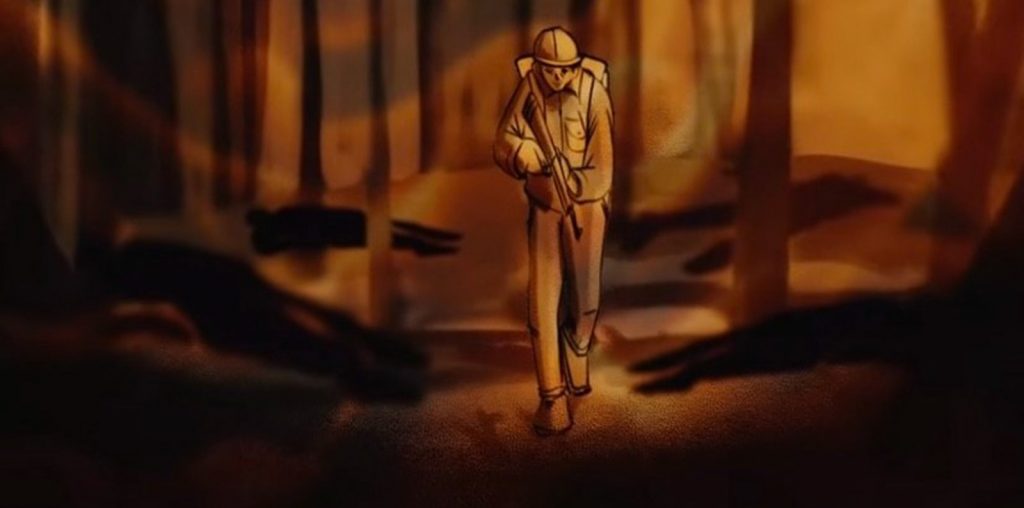
Any silent film tribute also needs to be a learning tool. After all, for such a film to succeed it must inform the sizable number of audience members unfamiliar with the style. It’s no small feat to inform and entertain; perhaps this is why such tributes, like the films of Guy Maddin (which often reinterpret or deconstruct the style of old) come from passion. Countless obstacles confront filmmakers with such a goal, since the minimal audience will turn off many financiers and producers. For the filmmakers (and the fans – yours truly included), this kind of film must be made.
The same feeling is behind The Artist, a (mostly) silent film tribute by Michel Hazanavicius that is, quite obviously, more faithful to earlier examples than Maddin. The film chronicles the birth of sound through the eyes of a silent star, George Valentin (Jean Dujardin), a swashbuckling Rudolph Valentino type who soon becomes obsolete in the new style. Earlier, during a fan greeting that turns into a photo op, he meets a young hopeful actress, Peppy Miller (Bérénice Bejo), whose spunk and look will suit the early talkies. The only thing missing from her is a bit of personality, which Valentin provides in the form of a beauty mark on her lip. That these two non-American actors (Dujardin is French, Bejo Argentinian) work so well in a silent Hollywood medium is noteworthy, while faces well known to American audiences – John Goodman and James Cromwell – play a producer and Valentin’s butler, respectively. Dujardin seems well versed in satire/tribute, having starred in Hazanavicius’ OSS 117 007 parody films. Dujardin’s matinee idol smile is like the product of a time machine, and Bejo, best known in America for her role in Brian Helgeland’s A Knight’s Tale, can turn heads no matter what company she keeps (though her thinness, in contrast to starlets of the time, feels like a product of female body anxiety caused by the current media).
The basics of the plot are common to the time period. The chance meeting of Valentin and Miller comes when she’s about to ascend and he descend, a moment beginning their romance. Valentin, in a cold marriage, admires Miller from afar, while she makes an effort to see him. She’s soon cast as an extra in his film, instructed to briefly dance with him. Valentin ruins take after take of their one shot together, his interest growing with every embrace as each take yields a different result (which would make any contract director pull out his hair). The romance feels true at first, until Valentin hits hard times, and we struggle to buy Miller’s continual dedication, going out of her way to see him as her career catapults. Hazanavicius’ intent may have been to reproduce suspension of disbelief, a common element of the American golden age. But in a film looking back, it’s not such an easy sell. We’re unsure if Miller suffers from displaced fan obsession, or if some unfortunate romantic-maternal instinct has kicked in.
The film passing into the sound era is also problematic. Hazanavicius begins in stride, then asks viewers to remain in the silent mode as the talkie era starts, or imagine an early talkie style beneath the silence that Valentin wishes would remain (it’s unclear which). Valentin takes control by becoming his own director, a move highlighting the film’s title. We can’t experience any of his struggles with sound (so endearing in Singin’ in the Rain), but only guess about them. The motif that Valentin is trapped in silence, and may never emerge, is notable but clunky much of the time.
And yet Hazanavicius and cinematographer Guillaume Schiffman show their expertise of early cinema through the visual style. The filmmakers compose and photograph the scenes-within-the-movie just right. The reduced visual planes of the dancing scene look just like those of the early studio. During Valentin’s preparation for the scene, Miller dances behind an elevated canvas held by two amused prop boys. The set piece, based on beauty and rhythm of her legs, is in kind with early aims to maximize the camera’s magic of capturing kinesis. Hazanavicius spreads such moments throughout the film. Later, when the two meet at the studio after the great change, they talk in front of a tiered stairway that reflects the machine-like work of the Hollywood studio. The moment represents the love of early Hollywood and a criticism of it, informed by Chaplin’s Modern Times.
If only the latter plot developments didn’t overburden the style. The romantic arc is too commonplace in spite of the refreshed old-time visuals. Not that Valentin’s character should have taken a different path. This fact of film history is all too true. But writer-director Hazanavicius needed to conceive some new moments and story beats to transform his exercise into dramatic tribute. In Mel Brooks’ Silent Movie, the slapstick conceits send up the silent clowns while the contemporary absurdism frames the material for modern viewers. In the more eye-pleasing The Artist, the plot eventually comes too close to its inspiration, though its early moments were headed for mastery – and transformation – of style.
